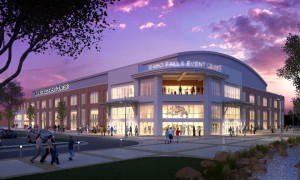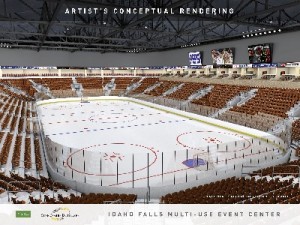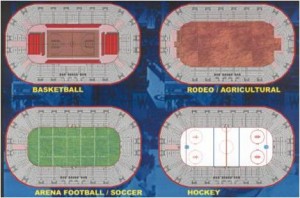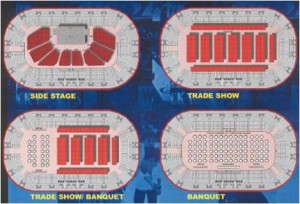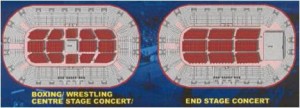Vision
One of the first questions citizens of Idaho Falls ask about the proposed Event Center is, “What will it look like?” That question is usually followed by, “What kind of events will it attract?” Because it is easier to show someone the vision, the Advisory Committee went to work to create a general model of what the proposed facility would look like.
The Advisory Committee envisioned a facility with a sports team as the anchor tenant. The preliminary design includes ice capability sufficient for professional hockey. Furthermore, the Center must have the flexibility to serve as a convention and conference center with the ability to host major tradeshows and conferences that cannot currently be hosted in Idaho Falls.
Important note: it is not the intent of the advisory committee or the community to build a facility that will compete with local business that can handle smaller, local and regional events. Rather, it is the goal to create a facility to attract larger events that currently cannot be accommodated with local facilities.
After researching eighteen (18) facilities in like-sized communities, collecting feedback from local citizens, and using data collected from a third party feasibility study, it was clear the Idaho Falls community wants and needs a multi-purpose facility. One that can attract major events such as: minor league sports, family shows like Disney on Ice, performing arts, rodeos, tournaments (college, state and local high school basketball, volleyball, wresting, etc. ), trade shows, conferences and more. Most important is creating a venue that will enhance the quality of life in the region and attract new businesses and visitors to Idaho Falls.
With this in mind, the Chamber of Commerce Board of Directors tasked the Advisory Committee with selecting an architectural firm to produce preliminary drawings of what this facility will look and define its potential uses.
Selection of Architectural Firm
The process for the selection of an architectural firm was very similar to the site selection process. A Request for Qualifications (RFQ) was published in local, regional, and national trade publications and websites. Architectural and engineering firms were invited to submit a response to the following list of qualifying criteria to provide preliminary and early concept design services for a multi-use events center in Idaho Falls.
• Experience with mid-size events centers (5000 to 6000 seat) that include a sports arena and specifically an ice facility
• Experience with concert quality acoustics
• Identify the team of people and their experience that would be assigned to this project
• Indicate whether your firm has an Idaho Falls or Idaho presence and, if so, where would the actual design work would be accomplished.
• Describe your experience working within a private development
• Experience with municipal projects
• Experience with CMCG (construction mgr./general contractor) projects
• Describe the approach to sustainability and operations and maintenance
• LEED experience
• Describe the approach to relate to the community
• Existing architecture
• Community programs
• Describe the approach to access including public and vendor
• Describe flexibility of payment terms
• Approach to community and owner input into design
• Experience with cost effective design
• References
Selected Firm
More than 30 firms from all over the country submitted proposals. Advisory Board members used the above criteria and a weighted system to determine the final four firms that were invited to interview with the advisory board. The weighted system was designed to give certain criteria greater value than others. For example, experience with mid-size events centers (5000 to 6000 seat) that include a sports arena/ice facility would receive a greater value than experience working within a private development.
After interviewing the final four firms, the committee selected local architectural firm CRSA and its partner Sink Combs Dethlefs Architects to design the project.
CRSA has been an integral part of community-building throughout the Western Mountain Region since 1975. With a body of creative and innovative design work in the areas of urban design, community and institutional planning, historic preservation, and the design of civic, commercial, cultural, and institutional projects, the firm’s award winning work can be found in communities large and small. Recognized regionally as a leader in community-centered design, their services will include architecture, planning and landscape architecture for the Event’s Center.
Sink Combs Dethlefs is recognized internationally as a leader in multiuse arena and event center design. The mid-sized firm, established in 1962, maintains offices in Denver and Chicago. It has contributed its expertise to dozens of sports and exhibition projects throughout the world, working closely with municipalities, universities and private organizations to create designs that meet the specific needs of the owners and users. They excel particularly with mid-sized arenas and have recently completed these event centers: Independence Event Center, 1st Bank Event Center, Tim’s Toyota Center, and the Wenatchee Town Toyota Center.
CRSA and Sink Combs Dethlefs partnered to provide the local presence and arena design expertise needed for the project. The team assembled has unparalleled, relevant experience and ability.
Steps Taken to Craft The Preliminary Concept Design
In the summer of 2010, utilizing the feasibility study, collected research and data, as well as their previous experience, CRSA and Sink Combs Dethlefs Architects worked with the Advisory Board to determine the size, functional qualities, and preliminary design approach for the Event Center to meet project demand and work within proposed budget parameters. Study data supported a conservative approach to the number of seats and venue size, which was determined to be 5,000 fixed seats with a project cost at $35-40,000,000. For its size and low cost per square foot, this was considered to be a cost conscious approach,which in part is a result of the gift of land to support the project.
CRSA and Sink Combs Dethlefs discussed key factors in successful event center design in order to understand how future funds may need to be allocated. Their knowledge of cost effective strategies for structural design was one key that helped focus the conceptual design on ways of creating a venue that would be easy to navigate and, equally important, easy and efficient to operate. Seating configurations to enhance the audience experience at events that will be as diverse as an ice hockey game, major music concert or a sportsman’s exposition were reviewed and specific requirements relative to ADA requirements/viewing have been identified and will be addressed. The Advisory Board and the design team reviewed the issue of revenue generation capacity, where a balance between amenities, such as suites and club seats, and market criteria could be found. By understanding the building market, potential event offerings and designing to meet but not exceed demand, the Advisory Committee was committed to assuring future financial stability of the event center. The preliminary design resulted from desire for the Event Center to serve as a beacon of community activity and pride, both from I-15 and within Idaho Falls. Clad in brick and stone the building sits adjacent to a public plaza, suitable for public gathering events like the Taste of Idaho. Parking has been distributed into smaller lots circling the Event Center, facilitating shorter walk times.
In all, the Idaho Falls Event Center has been conceived as a regional destination with a preliminary design to reflect the needs for a cost effective, durable and flexible venue for decades to come.


